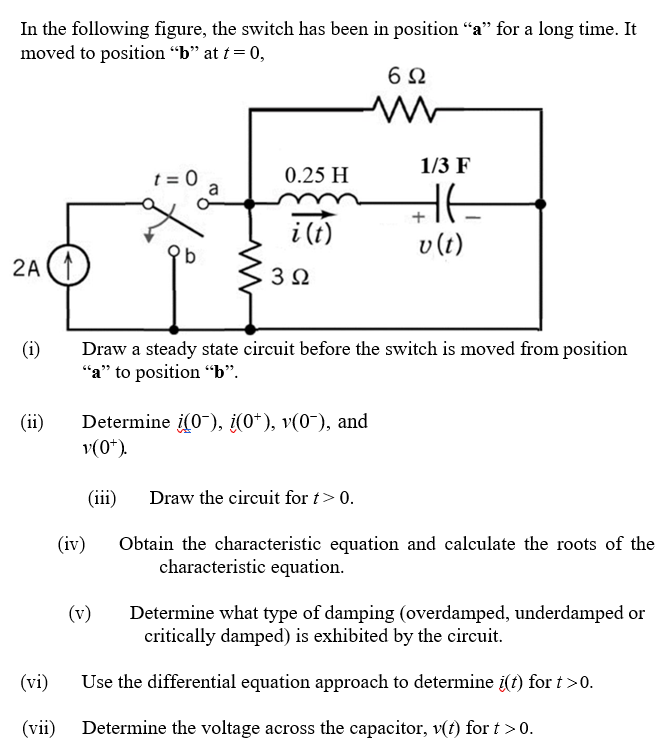In the following figure, the switch has been in position "a" for a long time. It moved to position "b" at t= 0, 1/3 F 0.25 H = 0 a + i (t) v (t) 2A 3 2 (i) Draw a steady state circuit before the switch is moved from position "a" to position "b". Determine i(0-), ¿(0*), v(0-), and v(0*). (ii) (iii) Draw the circuit for t> 0. (iv) Obtain the characteristic equation and calculate the roots of the characteristic equation.
In the following figure, the switch has been in position "a" for a long time. It moved to position "b" at t= 0, 1/3 F 0.25 H = 0 a + i (t) v (t) 2A 3 2 (i) Draw a steady state circuit before the switch is moved from position "a" to position "b". Determine i(0-), ¿(0*), v(0-), and v(0*). (ii) (iii) Draw the circuit for t> 0. (iv) Obtain the characteristic equation and calculate the roots of the characteristic equation.
Introductory Circuit Analysis (13th Edition)
13th Edition
ISBN:9780133923605
Author:Robert L. Boylestad
Publisher:Robert L. Boylestad
Chapter1: Introduction
Section: Chapter Questions
Problem 1P: Visit your local library (at school or home) and describe the extent to which it provides literature...
Related questions
Question

Transcribed Image Text:In the following figure, the switch has been in position "a" for a long time. It
moved to position “b" at t = 0,
1/3 F
t = 0
a
0.25 H
i (í)
v (t)
오b
2A
3 2
(i)
Draw a steady state circuit before the switch is moved from position
"a" to position “b".
Determine i(0-), ¿(0*), v(0~), and
v(0*).
(ii)
(iii)
Draw the circuit for t> 0.
(iv)
Obtain the characteristic equation and calculate the roots of the
characteristic equation.
Determine what type of damping (overdamped, underdamped or
critically damped) is exhibited by the circuit.
(v)
(vi)
Use the differential equation approach to determine i(t) for t>0.
(vii) Determine the voltage across the capacitor, v(t) for t > 0.
Expert Solution
This question has been solved!
Explore an expertly crafted, step-by-step solution for a thorough understanding of key concepts.
Step by step
Solved in 2 steps with 2 images

Knowledge Booster
Learn more about
Need a deep-dive on the concept behind this application? Look no further. Learn more about this topic, electrical-engineering and related others by exploring similar questions and additional content below.Recommended textbooks for you

Introductory Circuit Analysis (13th Edition)
Electrical Engineering
ISBN:
9780133923605
Author:
Robert L. Boylestad
Publisher:
PEARSON

Delmar's Standard Textbook Of Electricity
Electrical Engineering
ISBN:
9781337900348
Author:
Stephen L. Herman
Publisher:
Cengage Learning

Programmable Logic Controllers
Electrical Engineering
ISBN:
9780073373843
Author:
Frank D. Petruzella
Publisher:
McGraw-Hill Education

Introductory Circuit Analysis (13th Edition)
Electrical Engineering
ISBN:
9780133923605
Author:
Robert L. Boylestad
Publisher:
PEARSON

Delmar's Standard Textbook Of Electricity
Electrical Engineering
ISBN:
9781337900348
Author:
Stephen L. Herman
Publisher:
Cengage Learning

Programmable Logic Controllers
Electrical Engineering
ISBN:
9780073373843
Author:
Frank D. Petruzella
Publisher:
McGraw-Hill Education

Fundamentals of Electric Circuits
Electrical Engineering
ISBN:
9780078028229
Author:
Charles K Alexander, Matthew Sadiku
Publisher:
McGraw-Hill Education

Electric Circuits. (11th Edition)
Electrical Engineering
ISBN:
9780134746968
Author:
James W. Nilsson, Susan Riedel
Publisher:
PEARSON

Engineering Electromagnetics
Electrical Engineering
ISBN:
9780078028151
Author:
Hayt, William H. (william Hart), Jr, BUCK, John A.
Publisher:
Mcgraw-hill Education,